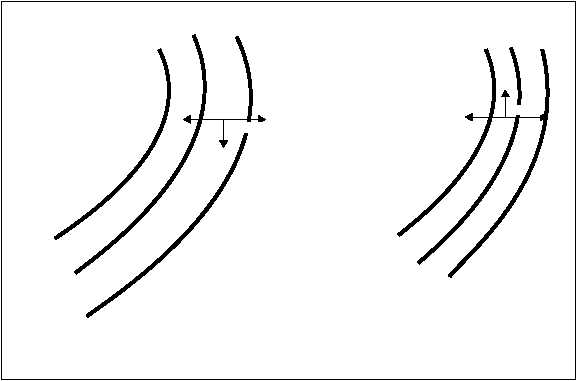decreases, the wind speed increases. If the density and
the latitude remain constant and the pressure gradient
decreases, the wind speed decreases. If the pressure
gradient and the latitude remain constant and the
density decreases, the wind speed increases. If the
density increases, the wind speed decreases. True
geostrophic wind is seldom observed in nature, but the
conditions are closely approximated on upper-level
charts.
Cyclostrophic Wind
In some atmospheric conditions, the radius of
rotation becomes so small that the centrifugal force
becomes quite strong in comparison with the Coriolis
force. This is particularly true in low latitudes where the
Coriolis force is quite small to begin with. In this case,
the pressure gradient force is nearly balanced by the
centrifugal force alone. When this occurs, the wind is
said to be cyclostrophic. By definition, a cyclostrophic
wind exists when the pressure gradient force is
balanced by the centrifugal force alone.
This exact situation rarely exists, but is so nearly
reached in some situations that the small Coriolis effect
is neglected and the flow is said to be cyclostrophic.
Winds in a hurricane or typhoon and the winds around a
tornado are considered cyclostrophic.
Movement of Wind around Anticyclones
The
movement
of
gradient
winds
around
anticyclones is affected in a certain manner by the
pressure gradient force, the centrifugal force, and the
Coriolis force. The pressure gradient force acts from
high to low pressure, and the Coriolis force acts
opposite to the pressure gradient force and at right
angles to the direction of movement of the parcel of air.
The centrifugal force acts at right angles to the path of
motion and outward from the center about which the
parcel is moving. (See fig. 3-12.) In the case of a
high-pressure center, the pressure gradient force and
the centrifugal force balance the Coriolis force. This
phenomenon may be expressed in the following
manner:
PG + CF = D
Movement of Wind around Cyclones
As in the case of anticyclones, the pressure gradient
force, the centrifugal force, and the Coriolis force affect
gradient winds around cyclones, but the balance of the
forces is different. (See fig. 3-12.) In a cyclonic
situation the Coriolis force and the centrifugal force
balance the pressure gradient force. This balance may
be expressed in the following manner:
3-12
1004
1024
1008
1016
1020
1012
PG = PRESSURE GRADIENT
CF = CENTRIFUGAL FORCE
ANTICYCLONE
CYCLONE
D = CORIOLIS FORCE
W = DIRECTION OF PARCEL OF AIR
AG5f0312
H
L
W
D
G
W
PG
CF
+
D
CF
+
Figure 3-12.—Forces acting on pressure systems.


